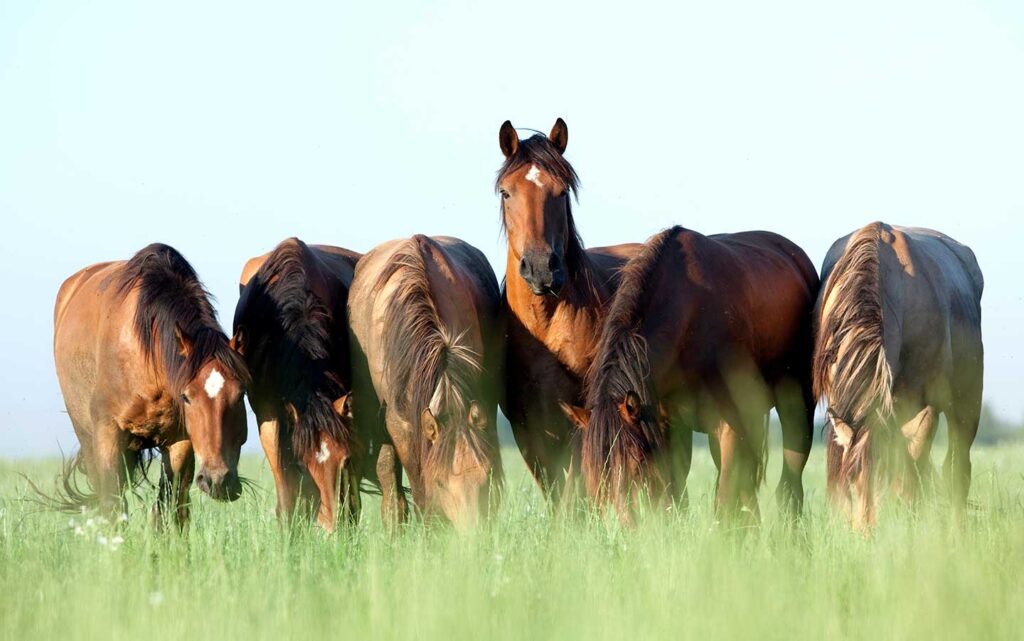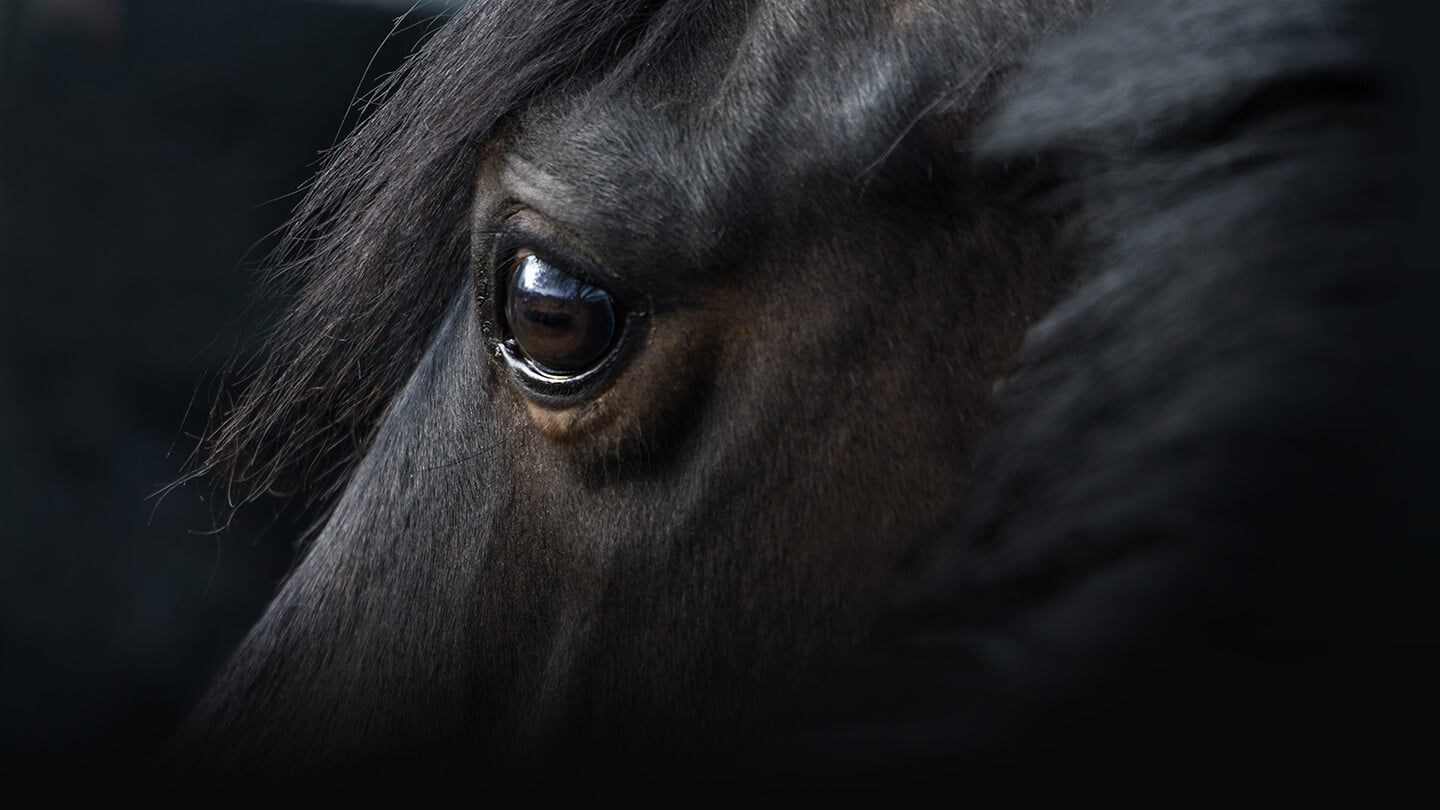With so many horse feed options available to us today, it can seem like a daunting task to pick the one that’s best for your horse. While the decision of choosing a horse feed can sometimes feel difficult and confusing, there are a few simple questions to ask in order to simplify the process and ensure you choose the feed that is not only best suited for your horse, but the highest quality as well.
Does the feed match my horse’s forage?
Forage, such as grass and hay, is the most important part of the horse’s diet. Horses should consume about 2.0% of their bodyweight in high quality forage per day. This means that a 1000 lb horse should eat at least 20 lb of grass/hay per day to stay healthy. The type of forage your horse consumes will impact what kind of feed you select. If you have access to high quality, calorie rich forages, then your horse may do best on a lower calorie commercial feed or ration balancer (depending on the horse’s activity level). Horses eating lower calorie, more mature forages may need to be fed higher calorie, highly fortified grain mixes to make up for the nutrition lacking in the forage.
The type of forage your horse consumes will impact what kind of feed you select. If you have access to high quality, calorie rich forages, then your horse may do best on a lower calorie commercial feed or ration balancer (depending on the horse’s activity level). Horses eating lower calorie, more mature forages may need to be fed higher calorie, highly fortified grain mixes to make up for the nutrition lacking in the forage.
Does this horse feed support my horse’s physiological state and activity level?
There are many different physiological states that a horse can be in, such as pregnancy, lactation, growing, performance and maintenance. Horses that are breeding, growing and performing will have different nutrient requirements than horses at maintenance. They will require feeds with higher calorie content, higher protein and higher vitamin and mineral fortification. In addition, a horse’s activity level will affect how he needs to be fed. Performance horses can be separated into activity levels of light, moderate, heavy and very heavy. Energy needs dramatically increase in proportion with activity levels, so horses in the heavy and very heavy activity levels will need higher calorie feeds than those working at light or moderate levels.
They will require feeds with higher calorie content, higher protein and higher vitamin and mineral fortification. In addition, a horse’s activity level will affect how he needs to be fed. Performance horses can be separated into activity levels of light, moderate, heavy and very heavy. Energy needs dramatically increase in proportion with activity levels, so horses in the heavy and very heavy activity levels will need higher calorie feeds than those working at light or moderate levels.
Does my horse need a feed formulated for a special age group?
 Horse’s nutritional requirements are greatly affected by age. Younger horses have much higher nutritional needs than adult horses, as they are growing and need a higher plane of nutrition to support bone, tendon and muscle development. Typical growth feeds are between 14% and 16% crude protein with lysine levels of at least 0.8%. They will also have increased vitamin and mineral fortification. Along with growing horses, older horses will have special nutritional needs. Since older horses cannot digest nutrients as efficiently, senior feeds will often have higher levels of protein, vitamins and minerals to ensure good senior horse health. Senior feeds should also be easy to chew and higher in fiber, since many senior horses have dental problems that lead to them not being able to properly chew and digest forage.
Horse’s nutritional requirements are greatly affected by age. Younger horses have much higher nutritional needs than adult horses, as they are growing and need a higher plane of nutrition to support bone, tendon and muscle development. Typical growth feeds are between 14% and 16% crude protein with lysine levels of at least 0.8%. They will also have increased vitamin and mineral fortification. Along with growing horses, older horses will have special nutritional needs. Since older horses cannot digest nutrients as efficiently, senior feeds will often have higher levels of protein, vitamins and minerals to ensure good senior horse health. Senior feeds should also be easy to chew and higher in fiber, since many senior horses have dental problems that lead to them not being able to properly chew and digest forage.
Does this feed match my horse’s ability to maintain weight?
Just like people, horses will have different metabolisms. Some horses seem to stay plump on the air they breathe, while others struggle to maintain weight no matter how much they are fed. It is vital that a horse’s feed support his individual metabolism. Easy keepers, or those horses who have no trouble holding good bodyweight (and may even be overweight), should be maintained on feeds that are lower in calories so that they do not cause obesity. On the other hand, hard keeping horses will require commercial feeds that are energy dense and provide the calories needed to keep weight on these horses. Ideally, feeds for hard keepers will be high in fats to provide calories that are safer than those from sugar and starch.
Is this feed low starch and sugar?
It is well documented in equine research that diets low in starch and sugar are safer for horses and reduce the risk of many physical problems. Too much sugar and starch, or non-structural carbohydrates (NSC), is directly linked to laminits, insulin resistance, ulcers, colic, diarrhea and behavior issues. Because of these potential dangers, quality horse feeds will use energy sources coming from fat and digestible fibers, as these calories are safer and do not bring the health hazards that soluble carbohydrates do. In general, feeds that are higher in fat and fiber and lower in sugar and starch are healthier options than those that are high in NSC. Commercial feeds that have a high content of cereal grains will be much higher in NSC than those that are based on ingredients such as beet pulp, soybean hulls and rice bran.
Are the ingredients in the horse feed high quality?
It’s often been said that “you get what you pay for,” and this has never been truer than in commercial horse feeds. In order to keep feed costs low, many feed companies will use inferior ingredients in their formulations. An inferior ingredient is one that is less digestible, which results in a feed that cannot maintain a horse’s bodyweight or perform as expected. Examples of some lower quality ingredients that you may find in commercial feeds are oat mill by-products and distillers dried grains, as well as peanut and rice hulls. Oat mill by-product is a lower quality fiber ingredient that is not entirely digestible. Distiller dried grains are a lower quality protein source that is highly variable, so can create problems with consistent amino acid content and palatability.  Soybean meal, soy hulls, beet pulp, and rice bran are some of the highest quality ingredients we have for commercial horse feed formulations, so it is best to choose feeds that have high levels of these ingredients.
Soybean meal, soy hulls, beet pulp, and rice bran are some of the highest quality ingredients we have for commercial horse feed formulations, so it is best to choose feeds that have high levels of these ingredients.
Is this feed fixed formula?
There are two methods that feed companies can use for product formulation: least cost and fixed formula. Least cost horse feeds are those where the company takes ingredient cost into account when formulating the feed, therefore producing a feed using the least cost ingredients possible. The problem with least cost formulation is that feed ingredient prices vary dramatically from week to week. As the cost of basic ingredients change, so will the formula. While the nutrient guarantees on the tag won’t change, the ingredient combination in the feed most certainly will. The horse’s digestive system is very sensitive to abrupt changes, so least cost formulations can result in the horse going off feed, gas and even colic. Fixed formula feeds, on the other hand, are made from formulations that do not change no matter what the ingredient market does. In general, fixed formula feeds are those that do not have a sewn on tag on the feed bag – the ingredients are printed directly on the feed bag itself. Also, fixed formulation feeds will not use general terms such as “grain products” or “molasses products.” They will list each specific ingredient individually.
Are the grains in this horse feed optimally processed?
One of the hallmarks of a good horse feed is that it will provide the horse’s nutritional needs without creating digestive or metabolic upset. Processing feeds, such as by pelleting or extruding, has been consistently shown to decrease digestive upset in horses while increasing nutrient digestibility. During the pelleting process, feed ingredients are ground into fine particles before being heated by steam. The ingredients in a pelleted feed are not cooked however, as that would destroy vitamins and minerals. The steam used is just high enough in temperature to break up complex starch molecules, making them more digestible, but not damage any other nutrients. Extrusion, on the other hand, uses high pressure temperatures much higher than those used during the pelleting process. Extruded feeds look very different than your typical horse feed in that they usually are in a kibble form. Both pelleting and extrusion increase ingredient digestibility, especially of starch. However, extruding a horse feed can create a few issues. For one, the high heat used during extrusion tends to destroy some of the feed’s natural vitamin content, forcing the feed company to add extra amounts of these vitamins to compensate. This extra vitamin supplementation adds increased cost to the end consumer. Additionally, extruded feeds have been shown to actually have a negative effect on the horse by increasing the glycemic response to that feed. The glycemic response is a measure of the rise in a horse’s blood glucose after a meal. This can be detrimental to horses that are sensitive to changes in their blood glucose levels, such as those suffering from insulin resistance, Cushing’s disease or EPSM. Also, this high glycemic response can lead to behavior problems such as hyperactivity.
During the pelleting process, feed ingredients are ground into fine particles before being heated by steam. The ingredients in a pelleted feed are not cooked however, as that would destroy vitamins and minerals. The steam used is just high enough in temperature to break up complex starch molecules, making them more digestible, but not damage any other nutrients. Extrusion, on the other hand, uses high pressure temperatures much higher than those used during the pelleting process. Extruded feeds look very different than your typical horse feed in that they usually are in a kibble form. Both pelleting and extrusion increase ingredient digestibility, especially of starch. However, extruding a horse feed can create a few issues. For one, the high heat used during extrusion tends to destroy some of the feed’s natural vitamin content, forcing the feed company to add extra amounts of these vitamins to compensate. This extra vitamin supplementation adds increased cost to the end consumer. Additionally, extruded feeds have been shown to actually have a negative effect on the horse by increasing the glycemic response to that feed. The glycemic response is a measure of the rise in a horse’s blood glucose after a meal. This can be detrimental to horses that are sensitive to changes in their blood glucose levels, such as those suffering from insulin resistance, Cushing’s disease or EPSM. Also, this high glycemic response can lead to behavior problems such as hyperactivity.  To further complicate matters, extruded feeds are less dense than other feed types, so a scoop of an extruded feed may be equal in weight to only half a scoop of a pelleted feed. This means that you may need to feed more of an extruded feed to get the same amount of nutrition. While extruded feeds show promise, at this current time no one has shown that there are any benefits that cannot be found in a pelleted feed.
To further complicate matters, extruded feeds are less dense than other feed types, so a scoop of an extruded feed may be equal in weight to only half a scoop of a pelleted feed. This means that you may need to feed more of an extruded feed to get the same amount of nutrition. While extruded feeds show promise, at this current time no one has shown that there are any benefits that cannot be found in a pelleted feed.
Beth Stelzleni, M.S., PAS
Seminole Feed®


